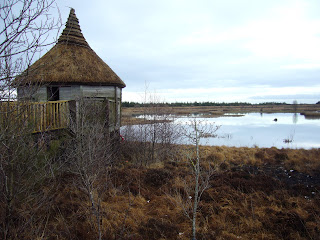By and large, most birds look the same. Well, different species obviously look different (or, at least, most different species look different - some only sound different, but I digress), but within the same species, most birds all look the same. Yes, in some cases, you can tell the boys from the girls due to plumage or size differences. And occasionally, you can get some idea of age. Okay, so I admit that it is possible (with careful observation) to tell some individuals from another, but by and large, from a distance, in fading light and without your bins to hand, one adult male Greenfinch skulking in a bush looks pretty much like the next.
 |
Female Greenfinch
(note careful positioning on same branch as the male!) |
|
Male Greenfinch
(looking the same as nearly all other male Greenfinches) |
Sometimes, however, you get one that you can see is different from a distance. Occasionally they might have a white feather, or a distinctive injury. Very occasionally you get a true colour variant, such as an albino (white), melanistic (dark) or (in the case below) leucistic (lightly-coloured) variant. These colour variants occur in most species, albinism being probably the best known (you can even get albino humans). Albinos have no melanin to colour skin, hence they are white. Leucism is rather different in that all skin pigments (not just melanin) are present, but at reduced levels. Again, leucism occurs in a variety of animals and are generally described as being the colour of milky tea (or "tay" as its called locally (you see - cultural enlightenment as well as peals of birding wisdom)).
 |
Leucistic Greenfinch
(affectionately known by me as Lucy) |
In truth, the photos don't actually do the bird justice. Looking at the photo in isolation, most folks have gone "a Greenfinch...? What's so special about that?". However, in the flesh it is strikingly pale (referred to by my long-suffering partner (Mrs OBB) as "the funny white bird", and it takes something for her to notice). Most colour variants tend to get picked on by their fellow species, and are often more easily picked off by predators. This one, however, appears to be fairly high up in the garden Greenfinch pecking order, and doesn't suffer anyone sharing "her" feeder. As a result, getting a shot of her next a normal-looking Greenfinch hasn't been too easy, but when you see her with another one (albeit a male in the pciture below), the paleness of her feathers really does stand out. I wonder, with the recent snow this winter and the promise of more to come, whether such a pale bird would have a competitive advantage over her normal, darker brethren. Probably not - she's just a freak!
 |
Bog Standard Greenfinch (top left) and Lucy
(and a Starling's tail top right!) |











